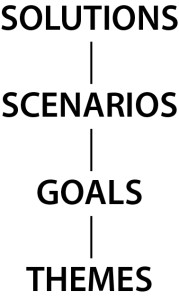
Why use the NADI-model?
The model of human Needs and Aspirations for Design and Innovation (NADI) is aimed at making people aware of the different levels of depth of insights into human needs and aspirations, and how these levels affect the design and innovation process.
How was the NADI-model developed?
I developed the model by comparing the work of Kees Dorst on ‘themes’ to the work of several scholars in the design research and design thinking field who suggest that deep customer or user insights support radical innovation.
How does it work?
The NADI-model defines four levels of depth in insights that are used to drive design and innovation. The top level of the NADI-model consists of the solutions level. It describes what types of solutions people want or need. For example, I asked one of my friends what she liked about her newly acquired Audi TT and she said she liked the car seat heating and the convertible roof. The second level in the model is the scenario level. It describes how people want to interact with solutions in certain scenarios. For example, my friend indicated that she liked it that when she was driving it on her own she would get a lot of attention. She also liked how the car was very easy to manoeuvre through heavy traffic. The third level is the goal level. It describes what people want to achieve with a solution, within the context of that design problem. My friend indicated that she loved it that she had this car all to herself. This was her car. Her goal was to have a car just for her. But when I finally asked her if this was her dream car, and if so why, she answered that now her kids were old enough to drive their own cars, she finally did not need a people mover anymore. The car symbolised her newly found sense of independence. This sense of ‘independence’ is a ‘theme’, which is the deepest level of the model. It describes what someone aspires or needs outside the context of the problem. The car also clearly relates to her sense of ‘identity’ as she was referring to liking getting attention while driving the car. Independence and identity are themes that everyone experiences in a way.
Themes are a construct that is taken from phenomenology. Themes are defined by the philosopher van Manen as the ‘structures of experiences’. They are closely related to human values and meanings. Think of words such as ‘belonging’, ‘guidance’, ‘contribution’, ‘trust’ etc. Because themes are relatively stable and are shared across many people, they can be explored independently of the problem.
The model can be used to better understand what kinds of insights are gathered through various design research methods, and how these insights affect the design and innovation process. Kees Dorst (2015) for example showed that analysing themes supports reframing of problems, and through that supports radical innovation. See this blog for an explanation of the development and use of the model. If you would like to know more you can also read this paper that was recently published in Design Studies, or the paper I wrote for the 2014 Design and Emotion conference about this topic.
Van der Bijl-Brouwer, Mieke & Kees Dorst. “Advancing the Strategic Impact of Human-Centred Design”, Design Studies vol. 53 (November 2017): p1-23, 2017
Dorst, Kees. Frame Innovation; Create New Thinking by Design. Design Thinking, Design Theory. edited by Ken Friedman and Erik Stolterman Cambridge, Massachusetts: The MIT Press, 2015.
van der Bijl – Brouwer, Mieke, and Kees Dorst. “How Deep Is Deep? A Four-Layer Model of Insights into Human Needs for Design Innovation.” In Proceedings of the Colors of Care: The 9th International Conference on Design & Emotion, edited by J. Salamanca, P. Desmet, A. Burbano, G. Ludden and J. Maya, 280-87. Bogotá: Ediciones Uniandes, 2014.